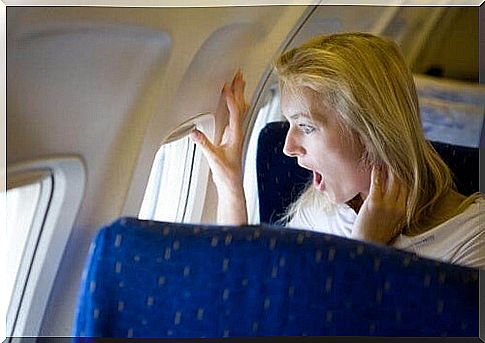Fear Of Flying – Get Rid Of It In 5 Easy Steps

The fear of flying is aerophobia. It can take many different forms, but is for the most part characterized by concerns about air travel. This article will help you understand and overcome your fear of flying.
Fear of flying: symptoms and causes
Fear of flying is more common than you think. As many as one third of passengers suffer from aerophobia.
For this reason, many airlines offer courses (often free) that allow passengers to face their fear and overcome their phobias. After all, the fear of flying is not necessarily a self-contained phenomenon and may be accompanied by claustrophobia (fear of confined spaces) or acrophobia (fear of heights).
The fear of flying is often discussed because of its consequences.
Although flying is the safest form of transport, for people who have a strong fear of flying, the problem is that they do not know what can happen during take-off, flight and landing.
In addition, not being able to stand firmly on the ground increases anxiety.
The fear of flying manifests itself in various fears, such as:
- “The plane will crash”
- “I’m going to have a panic attack”
- “I won’t be able to get out”
- “I’m going to be claustrophobic”
- “There will be turbulence and strange noises”
- “I will not get adequate help if I have a heart attack”
- “I will fly over the ocean or overnight in complete darkness”
- “I will have no control over the situation”
Experienced trauma can also cause fear of flying.
For example, you may experience aerophobia if a loved one or a friend died in a plane crash, or if you experienced severe turbulence or a forced landing during your first flight. Watching movies about air accidents can also contribute to the development of phobias.
Aerophobia can also occur under the influence of the media. New forms of communication make it possible to show air crashes frequently and inform about the number of victims in a sensational way designed to cause shock and fear, and not in a form showing the accident as a single event.

Fear of flying: how to get rid of it?
People who are unable to travel to distant places due to phobias should opt for therapy. This will help them control their fear.
Here is a list of techniques that can be of great help.
1. Learn the principles of operation of airplanes
You don’t have to become a pilot or flight attendant to understand the basics of airplanes.
Read about what happens with the machine during take-off and landing, what the flight itself is about, what you can do to make your trip safe, what you need to prepare for, how many tests and checks the plane passes before each course, etc.
Perhaps it will reassure you to learn about the laws of physics that govern flight and how wings, engine and other parts of the machine work.

Airplanes are constantly checked and kept in perfect technical condition. Before the pilot can take off, everything must be absolutely in order.
In addition, there are eleven hours of maintenance for every hour of flight. Thanks to this, the operator can be sure that each part and system is working properly.
2. Become familiar with the aviation safety statistics
It is true that when an air accident occurs, most passengers are killed. But the likelihood that a disaster will happen is less than the chance that you will die in a car accident.
To calm down, check out the statistics. While the news shows us various aviation accidents, the media definitely portrays them as overly publicized events rather than exceptional situations.
3. Be prepared for normal airplane vibration and movement
What Happens When Turbulence Occurs? What happens when the plane takes off? Why is the flight attendant telling us to wear seat belts? When our sense of security changes, we automatically assume that something bad is going to happen. But in fact it does not necessarily have to be that way.

Prepare for, among other things:
- Putting on earplugs (to counteract the unpleasant effect of a sharp change in pressure)
- Appearing emptiness in the stomach (caused by a fast start)
- Feeling the movement of the airplane wings (they are necessary to change direction and make the best use of the existing wind)
4. Don’t worry about turbulence
You may think turbulence is the worst part of flight. In fact, however, they are common and normal.
- If your flight is longer than 6 hours, at some point the plane will start to vibrate slightly more strongly.
- This occurs as the machine passes a low pressure area and then a high pressure area. This works in a similar way to driving a car on a rocky or potholed road.
- Flight attendants ask passengers to fasten their seat belts as part of standard safety procedures – this does not mean that something is wrong.
5. Take control of your anxiety
You have to realize that the flight is not up to you. So don’t worry about something beyond your control. You can practice relaxing and calming breathing so that you can take advantage of these techniques during takeoff and landing.

Imagine the place you are going to. Think about what you will experience, what you will see, who you will meet. Watch a movie, read a book, listen to music, play Sudoku or talk to your fellow passengers.
In this way, you will focus your attention on something other than what is happening around you.









